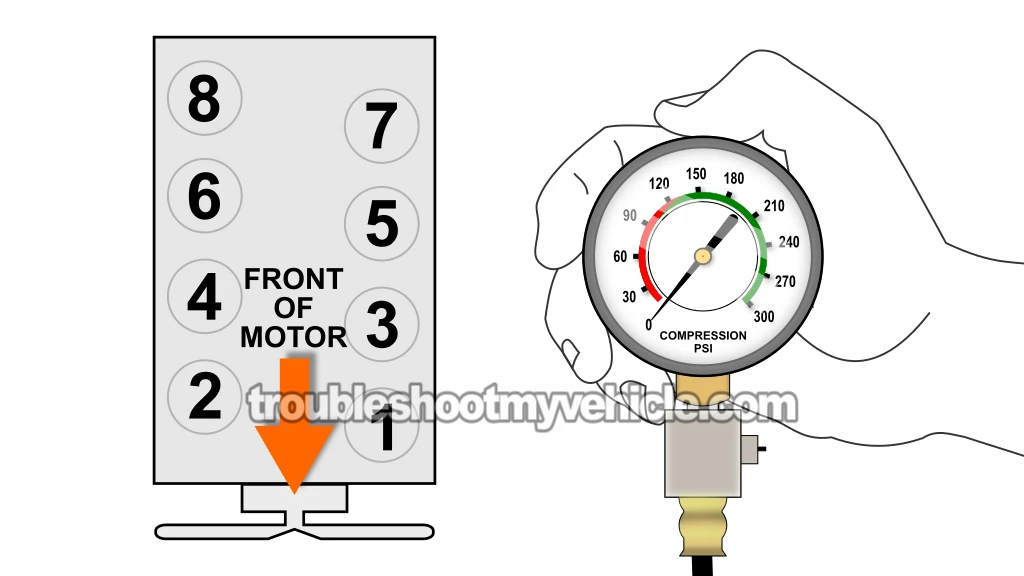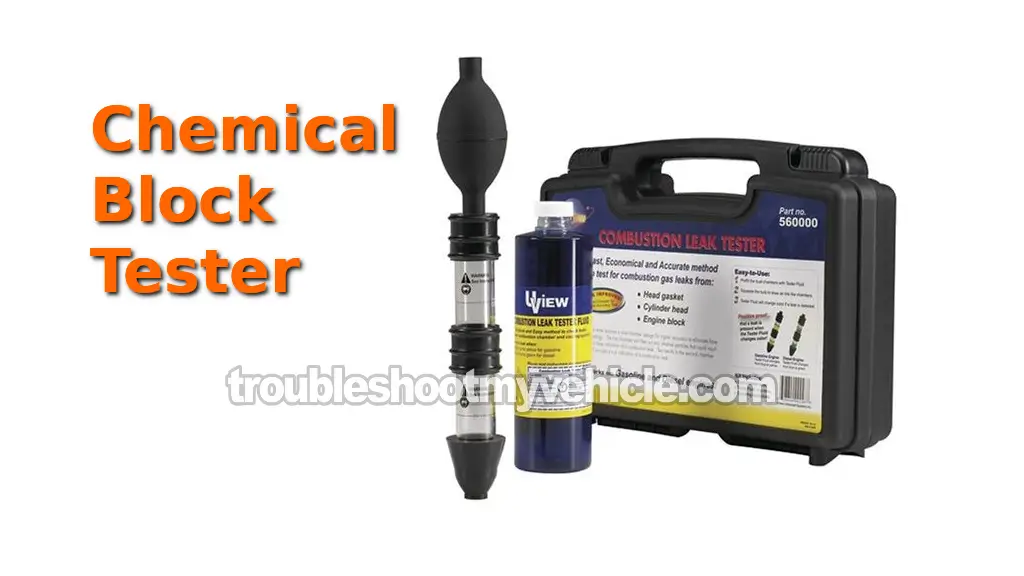TEST 3: Cylinder Compression Test

One of the most overlooked tests, to see if the head gasket is bad or not, is an engine compression test. Why? Well because most folks will do the two previous tests (TEST 1 and TEST 2) and they won't see the engine oil mixing with the coolant nor see the combustion gases jumping out of the open radiator and conclude everything is OK.
Unfortunately, it's possible for the head gasket to fail and not cause the oil to mix with coolant nor cause the exhaust gases to escape thru' the cooling system.
In this test section, you'll be doing a compression test and more importantly, you'll be able to easily interpret those results to further confirm or exonerate a blown head gasket.
This test will see if the head gasket on your V8 Dodge Ram van has burned at a point between cylinders.
If this does happen, the compression/combustion of one cylinder to leak into the other and vice-versa and you'll see:
- The engine has two side-by-side cylinders misfiring.
- The compression value of those two adjacent cylinders is 0 PSI.
NOTE: You can find the compression test explained in more detail here: How To Test Engine Compression (1989-2003 5.2L, 5.9L V8 Dodge Ram Van).
OK, here's what you need to do:
- 1
Disable the ignition system. It's important that spark isn't created and delivered to the spark plug wires.
You can easily accomplish this by disconnecting the ignition coil's electrical connector. - 2
Disconnect all 8 spark plug wires (from their spark plugs).
NOTE: Label the spark plug wires with the cylinder they belong to before you disconnect them from their spark plugs. - 3
Take out all 8 spark plugs.
- 4
Thread in the compression tester by hand, on the first spark plug hole you're gonna' start with.
NOTE: Don't use any tools to tighten the compression tester. Hand tightening the compression tester is more than enough to get the proper results. - 5
Have a helper crank the engine. Your job is to observe the compression tester.
- 6
Once the tester's needle stops climbing, have your assistant stop cranking the engine.
- 7
Write down the reading and what cylinder it belongs to (you can use the image above to help you identify the cylinder) on a piece of paper.
- 8
Remove the compression tester and repeat the above steps in the remaining cylinders.
OK, let's take a look at what your results mean:
CASE 1: All cylinder compression readings where normal (above 110 PSI). These compression gauge readings confirm that the head gasket is OK and not burned at a point between two cylinders.
OK, 3 out of 4 tests have confirmed that the head gaskets on your V8 Dodge van aren't blown. But, but if you're not convinced, check out the last test: TEST 4: Using A Chemical Block Tester (Combustion Leak Tester).
CASE 2: Two side by side cylinders had 0 PSI compression. This engine compression reading confirms that the head gasket is burned thru' at the point between those two cylinders. You'll need to replace both head gaskets.
TEST 4: Using A Chemical Block Tester (Combustion Leak Tester)

If your Ram van is still overheating, but the first three tests haven't confirmed a blown head gasket —and you've already:
- Checked and confirmed the thermostat is working properly,
- Verified that the fan clutch is in good shape, and
- Confirmed that the water pump is functioning correctly,
...then there's a strong possibility you're dealing with the early stages of a head gasket failure. The best way to know for sure is by performing a block test.
A block test (also known as a combustion leak detection test) is hands-down the most reliable method to check for a blown head gasket when the earlier tests don't give a definite answer.
Here's how this test works:
- You'll use a special tester filled with a blue chemical solution (see image above).
- The tester is placed on the radiator's open neck. You may need to drain some coolant first —the tool has to draw in air from inside the radiator.
- Next, start the engine and let it run.
- Use the rubber bulb on the tester to draw air from the radiator through the chemical-filled chambers. As the air passes through, it interacts with the fluid.
- If the blue fluid turns yellow (on gasoline engines), that means combustion gases are making their way into the cooling system —confirming a blown head gasket, a cracked cylinder head, or a cracked engine block.
- If the blue color stays the same, that's your green light —no combustion gases detected, and no head gasket or major internal engine problem.
You can shop for a block tester here:
Disclosure: As an Amazon Associate, I earn from qualifying purchases. If my tutorials help you, using these links is an easy way to support the site at no extra cost to you. Thank you!
Frequently Asked Questions
1.) How can I tell if the cylinder head is cracked?
- To know for sure, the cylinder head needs to be removed and carefully inspected. If the crack is big enough, it might be visible to the naked eye.
- However, cracks aren't always obvious. That's why it's a good idea to have a machine shop perform a pressure test —they can spot cracks that aren't visible during a basic visual inspection.
2.) Do I need to resurface the cylinder head?
- Absolutely —resurfacing is a must! Never reinstall a cylinder head (especially after overheating) without having it checked and resurfaced by a machine shop.
- The only exception is if both you and the machine shop check the head with a precision straight-edge and confirm there's zero warpage. Otherwise, resurfacing is necessary to ensure a proper seal.
3.) Should I remove both cylinder heads?
- Yes, it's best to remove both. That way, you can inspect each one for damage and, if needed, have a machine shop test them for cracks and warpage.
4.) Should I use a "Head Gasket Repair In A Can" solution?
- No, I don't recommended it.
- Even though it might seem like a quick fix, these products are just temporary band-aids. Even if it seems to work for a few weeks or months, you're still going to have to replace the head gaskets.
- And to make matters worse, you'll now be dealing with new problems:
- A clogged radiator and heater core.
- Restricted coolant flow due to gunk buildup in the coolant passages of the head and block —this can lead to overheating and more engine damage.
More 5.2L, 5.9L V8 Dodge Ram Van Tutorials
There are several more 5.2L, 5.9L V8 Dodge Ram Van specific 'how to' tutorials that I've written and you can find them here:
Here's a sample of the tutorials you'll find in the index:
- How To Test The Intake Air Temp (IAT) Sensor (1998-2003 5.2L, 5.9L V8 Dodge Ram Van).
- How To Test The TPS (1997-2003 5.2L, 5.9L V8 Dodge Ram Van).
- How To Test Engine Compression (1989-2003 5.2L, 5.9L V8 Dodge Ram Van).
- How To Test The MAP Sensor (1998-2003 5.2L, 5.9L V8 Dodge Ram Van).

If this info saved the day, buy me a beer!




